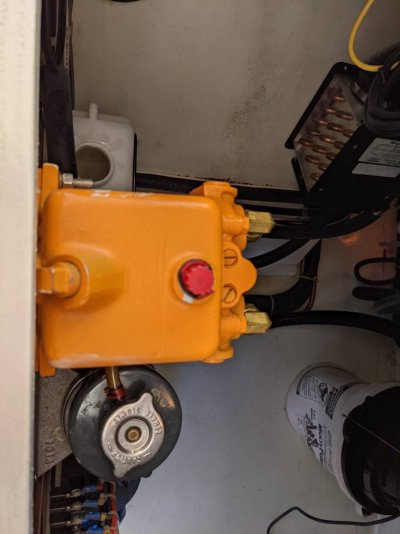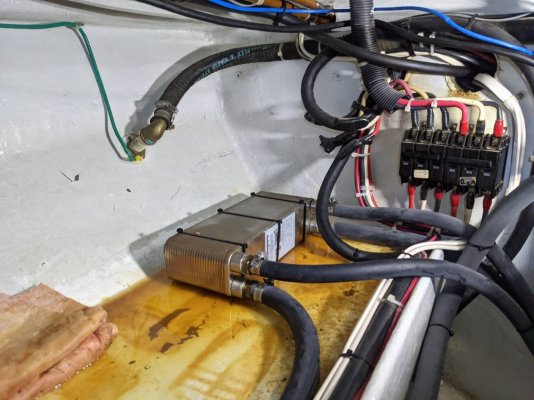fkerekes
Member
Woke up this morning to find coolant dripping from the ceiling, and upon investigation I discovered the hydronic heating loop overflow tank (plastic container at top of pic 1) spraying out inside the pilothouse steering station.
After much cursing and rummaging for containers to collect the overflow here and the dripping elsewhere (~3 gal) the overflow still wasn't slowing down at all. I did notice the color change from green to clear, so I started to suspect mixing between the coolant loop and fresh water circuit. After setting up a shop vac to give me my hands back I shut off the fresh water pump, bled the water pressure out, and confirmed the coolant expansion tank (grey tank with silver cap at bottom of pic 1) stopped overflowing.
The two fluid loops meet in the water heater (Raritan 172011), so I drained it and can now run the water pump briefly to wash dishes, etc, without any coolant expansion tank overflow.
Coolant circuit is something like this:
1. Pump
2. Webasto furnace
3. Standalone heat exchanger (exchange with engine coolant, pic 2)
4. Water heater
5. Several cabin fan radiators
6. Expansion tank
7. Return to pump
Standalone heat exchanger looks to be leaking at heater coolant input due to failed hose clamp, but I don't see how that's related to the overflow issue.
So my question is whether this is a common failure mode in heat exchanger water heaters? Poor zinc maintenance on my (and previous owner's) part?
I've had one fail before at the heat exchanger nipple causing the tank to leak into the bilge. I don't see any other evidence of leaks on this one, so it must be internal to the tank where coolant and fresh water are mixing. I'm guessing this one is a lost cause and needs to be completely replaced.

After much cursing and rummaging for containers to collect the overflow here and the dripping elsewhere (~3 gal) the overflow still wasn't slowing down at all. I did notice the color change from green to clear, so I started to suspect mixing between the coolant loop and fresh water circuit. After setting up a shop vac to give me my hands back I shut off the fresh water pump, bled the water pressure out, and confirmed the coolant expansion tank (grey tank with silver cap at bottom of pic 1) stopped overflowing.
The two fluid loops meet in the water heater (Raritan 172011), so I drained it and can now run the water pump briefly to wash dishes, etc, without any coolant expansion tank overflow.
Coolant circuit is something like this:
1. Pump
2. Webasto furnace
3. Standalone heat exchanger (exchange with engine coolant, pic 2)
4. Water heater
5. Several cabin fan radiators
6. Expansion tank
7. Return to pump
Standalone heat exchanger looks to be leaking at heater coolant input due to failed hose clamp, but I don't see how that's related to the overflow issue.
So my question is whether this is a common failure mode in heat exchanger water heaters? Poor zinc maintenance on my (and previous owner's) part?
I've had one fail before at the heat exchanger nipple causing the tank to leak into the bilge. I don't see any other evidence of leaks on this one, so it must be internal to the tank where coolant and fresh water are mixing. I'm guessing this one is a lost cause and needs to be completely replaced.


